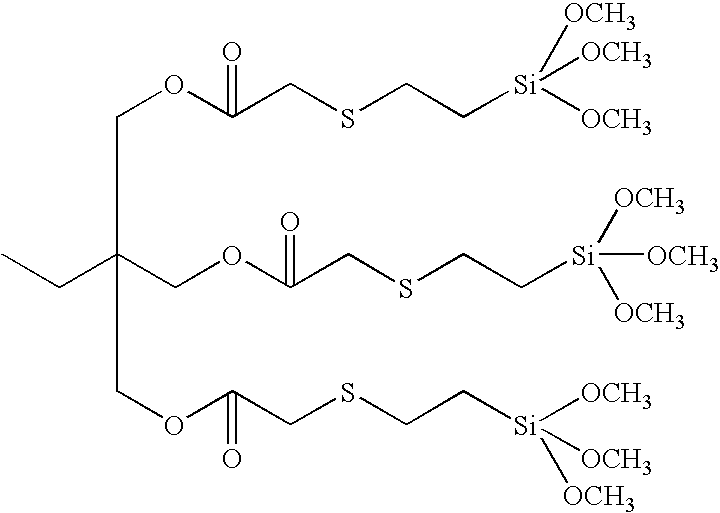Sulfur modified silanes for the elaboration of high refractive index materials
a technology of high refractive index and sulfur silane, which is applied in the direction of sulfur dyes, organic chemistry, solid-state diffusion coatings, etc., can solve the problems of unsightly fringes, unsuitable high-index lenses, and material haziness
- Summary
- Abstract
- Description
- Claims
- Application Information
AI Technical Summary
Benefits of technology
Problems solved by technology
Method used
Image
Examples
example 1
[0088]3,3′-thiobis[2-[(2-mercaptoethyl)thio]-1-Propanethiol (MR10B) and vinyltrimethoxysilane (VTMOS) are mixed together with tetrahydrofuran (THF) solvent to allow initial miscibility. The solution is placed in a vial and exposed to LTV irradiation. The thiol-ene addition takes place under UV, without addition of any catalyst. The reaction equation is as follows:
[0089]
By weight 13.23 g MR10B, 12.45g VTMOS, and 4.32g THF were combined in a glass vial to produce approximately 30 grams of solution. The irradiation step consisted of 5 passes under the Fusion UV source (H Bulb), by a conveyor belt at 4.95cm / s. The resulting polysulfide polysilane has a refractive index of 1.546.
example 2
[0090]By weight, 35.65 g of trimethylolpropane tris (2-mercaptoacetate) and 44.47 g vinyltrimethoxysilane (VTMOS) were mixed together and subject to UV radiation consisting of 5 passes under the Fusion UV source (H Bulb), on a conveyor belt at 4.95cm / s. The UV dose was 10.13 J / cm2 at an intensity of 3.401 Watts / cm2. A solvent was not necessary for miscibility of the VTMOS, but it could be optionally used. The resulting structure is:
[0091]
The polysulfide polysilane produced has a refractive index of 1.477.
example 3
[0092]Under conditions similar to Example 2, 10 g of 2-Mercaptoethyl Sulfide was combined with 19.22 g of VTMOS to produce the following compound:
[0093]
The compound has a refractive index of 1.509.
PUM
| Property | Measurement | Unit |
|---|---|---|
| RI | aaaaa | aaaaa |
| RI | aaaaa | aaaaa |
| refractive index | aaaaa | aaaaa |
Abstract
Description
Claims
Application Information
 Login to View More
Login to View More - Generate Ideas
- Intellectual Property
- Life Sciences
- Materials
- Tech Scout
- Unparalleled Data Quality
- Higher Quality Content
- 60% Fewer Hallucinations
Browse by: Latest US Patents, China's latest patents, Technical Efficacy Thesaurus, Application Domain, Technology Topic, Popular Technical Reports.
© 2025 PatSnap. All rights reserved.Legal|Privacy policy|Modern Slavery Act Transparency Statement|Sitemap|About US| Contact US: help@patsnap.com



